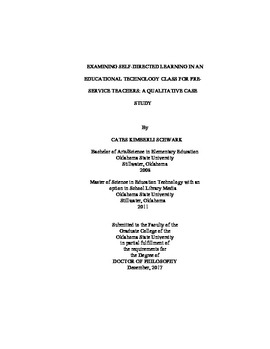| dc.contributor.advisor | Stansberry, Susan L. | |
| dc.contributor.author | Schwark, Cates Kimberli | |
| dc.date.accessioned | 2018-06-18T16:02:25Z | |
| dc.date.available | 2018-06-18T16:02:25Z | |
| dc.date.issued | 2017-12 | |
| dc.identifier.uri | https://hdl.handle.net/11244/300071 | |
| dc.description.abstract | The purpose of this case study was to explore a self-organized learning environments (SOLE) experience for adult learners to describe their response in relation to self-directed learning and curiosity in a self-organized learning environment. The participants in this study were students enrolled in two sections of an undergraduate educational technology course for pre-service teachers at a midwestern university. The study included 37 total students who were enrolled in the course. | |
| dc.description.abstract | This study was a descriptive case study based off of Merriam's (1998) guide for a descriptive case study. The scope of the study was two sections of one course during one semester. The phenomenon studied was providing support for the role of curiosity in a SDL adult learning environment. It is important to consider the context for this study along with multiple variables, exploring data, and altering instruction. The data collection was conducted during the first nine weeks of the course. Data sources included interviews, observations, focus groups, The Curiosity and Exploration Inventory II (Kashden et al., 2009) pre- and post-survey, and document analysis. Data analysis entailed open coding of transcripts from interviews and observations. Emphasis was given to identifying categories that "fit" the data. Repeatedly appearing categories and concepts helped to construct themes based on adult self-organized learning and curiosity. In order to help give structure and language to the findings, the final phase of analysis and interpretation applied both Knowles's (1975) and Merriam's (2001) Theory of Adult, Self-directed learning and Kashden et al.'s (2009) The Curiosity and Exploration Inventory II. | |
| dc.description.abstract | The findings revealed the pre-service teachers experience through SOLE demonstrated many elements of SDL and curiosity, adult learning. Further, findings described that using adult learning principles as a guide, learning was enhanced by many of the participants in the study. Findings from the Curiosity and Exploration Inventory II (Kashden et al., 2009) suggested curiosity was slightly enhanced through SOLE in an adult learning environment. | |
| dc.format | application/pdf | |
| dc.language | en_US | |
| dc.rights | Copyright is held by the author who has granted the Oklahoma State University Library the non-exclusive right to share this material in its institutional repository. Contact Digital Library Services at lib-dls@okstate.edu or 405-744-9161 for the permission policy on the use, reproduction or distribution of this material. | |
| dc.title | Examining self-directed learning in an educational technology class for pre-service teachers: A qualitative case study | |
| dc.contributor.committeeMember | Thompson, Penny | |
| dc.contributor.committeeMember | Asino, Tutaleni I. | |
| dc.contributor.committeeMember | Hathcock, Stephanie | |
| osu.filename | Schwark_okstate_0664D_15504.pdf | |
| osu.accesstype | Open Access | |
| dc.type.genre | Dissertation | |
| dc.type.material | Text | |
| thesis.degree.discipline | Educational Technology | |
| thesis.degree.grantor | Oklahoma State University | |
